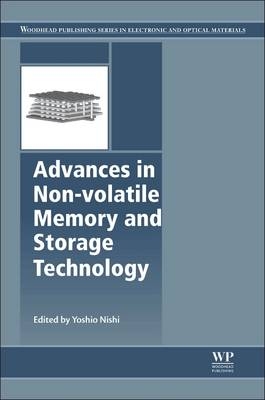
Advances in Non-volatile Memory and Storage Technology
Woodhead Publishing Ltd (Verlag)
978-0-85709-803-0 (ISBN)
- Titel erscheint in neuer Auflage
- Artikel merken
New solutions are needed for future scaling down of nonvolatile memory. Advances in Non-volatile Memory and Storage Technology provides an overview of developing technologies and explores their strengths and weaknesses.
After an overview of the current market, part one introduces improvements in flash technologies, including developments in 3D NAND flash technologies and flash memory for ultra-high density storage devices. Part two looks at the advantages of designing phase change memory and resistive random access memory technologies. It looks in particular at the fabrication, properties, and performance of nanowire phase change memory technologies. Later chapters also consider modeling of both metal oxide and resistive random access memory switching mechanisms, as well as conductive bridge random access memory technologies. Finally, part three looks to the future of alternative technologies. The areas covered include molecular, polymer, and hybrid organic memory devices, and a variety of random access memory devices such as nano-electromechanical, ferroelectric, and spin-transfer-torque magnetoresistive devices.
Advances in Non-volatile Memory and Storage Technology is a key resource for postgraduate students and academic researchers in physics, materials science, and electrical engineering. It is a valuable tool for research and development managers concerned with electronics, semiconductors, nanotechnology, solid-state memories, magnetic materials, organic materials, and portable electronic devices.
Professor Yoshio Nishi is a Professor in the Department of Electrical Engineering and by courtesy in the Department of Material Science and Engineering. He was Director of the Stanford Nanofabrication Facility of National Nanotechnology Infrastructure Network and is now Director of Research of Stanford Center for Integrated Systems at Stanford University, USA
1 Overview of non-volatile memory technology: markets, technologies and trends R. Bez and A. Pirovano, Micron, Italy Part I Improvements in flash technologies 2 Developments in 3D NAND flash technology R. Shirota, National Chiao Tung University, Taiwan 3 Multi-bit NAND flash memories for ultra high density storage devices R.Micheloni and L. Crippa, PMC-Sierra, Italy 4 Improving embedded flash memory technology: silicon and metal nanocrystals, engineered charge-trapping layers and split-gate memory architectures G. Molas, L. Masoero, CEA-LETI, France, V. Della Marca, ST-Microelectronics, France, G. Gay and B. De Salvo CEA-LETI, France Part II Phase change memory (PCM) and resistive random access memory (RRAM) technologies 5 Phase change memory (PCM) materials and devices S. Raoux, IBM T. J. Watson Research Center, USA 6 Nanowire phase change memory (PCM) technologies: principles, fabrication and characterization techniques M. Longo, National Research Council, Italy 7 Nanowire phase change memory (PCM) technologies: properties and performance M. Longo, National Research Council, Italy 8 Modelling of resistive random access memory (RRAM) switching mechanisms and memory structures K. Kamiya, Kanagawa Institute of Technology, Japan , M. Young Yang, University of Tsukuba, Japan, B. Magyari-Köpe and Y. Nishi, Stanford University, USA and K. Shiraishi, Nagoya University, Japan 9 Metal oxide resistive random access memory (RRAM) technology G. Bersuker and D. C. Gilmer, SEMATECH, USA 10 Conductive bridge random access memory (CBRAM) technology J. R. Jameson and M. Van Buskirk, Adesto Technologies Corporation, USA 11 Memristors for non-volatile memory and other applications G. M. Huang and Y. Ho, Texas A&M University, USA Part III Alternative emerging technologies 12 Molecular, polymer and hybrid organic memory devices (OMDs) A. Kiazadeh and H.Gomes,, Algarve University, Portugal 13 Nano-electromechanical random access memory (RAM) devices W. Kwon, University of California Berkeley, USA 14 Ferroelectric random access memory (FRAM) devices T.Eshita and T.Tamura, Fujitsu Semiconductor Ltd., Japan, and Y. Arimoto, Fujitsu Laboratories Ltd. , Japan 15 Spin-transfer-torque magnetoresistive random access memory (STT-MRAM) technology H. Ohno, T. Endoh, T. Hanyu, Y. Ando and S. Ikeda, Tohoku University, Japan
| Reihe/Serie | Woodhead Publishing Series in Electronic and Optical Materials |
|---|---|
| Verlagsort | Cambridge |
| Sprache | englisch |
| Maße | 156 x 234 mm |
| Gewicht | 940 g |
| Themenwelt | Informatik ► Weitere Themen ► Hardware |
| Technik ► Elektrotechnik / Energietechnik | |
| ISBN-10 | 0-85709-803-9 / 0857098039 |
| ISBN-13 | 978-0-85709-803-0 / 9780857098030 |
| Zustand | Neuware |
| Haben Sie eine Frage zum Produkt? |
aus dem Bereich



